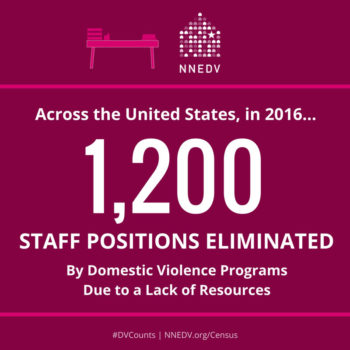11th Annual Census Illuminates Critical Services, Highlights Gaps in Domestic Violence Field
May 11, 2017
Report shows that while more than 72,000 victims of domestic violence received services on a single day, nearly 12,000 requests were turned away because programs lacked the resources to help
Washington, DC – (May 11, 2017)
Today, the National Network to End Domestic Violence (NNEDV) released the 11th annual Domestic Violence Counts census report. The 24-hour count [1] of services provided to adult and child victims offers a unique glimpse into the untold story of our nation’s domestic violence shelters.
“While you were sipping your coffee this morning, thousands of victims were waking up in a shelter, safe for the time being. When you dropped your kids off at school, thousands of children were heading into a new school, hauling backpacks provided by their shelter advocates. As you watch your evening shows tonight, thousands of survivors will be learning about protection orders and other services from unsung heroes: local domestic violence victim advocates,” said Cindy Southworth, NNEDV’s Executive Vice President.
Domestic violence programs provide desperately needed services to individuals who are very often fleeing for their lives. Shelters provide a safe haven in a time of fear and uncertainty, working closely with families, communities, law enforcement, health care workers, and other advocates.
The data revealed in this newly released report show that in just one day…
- 1,762 local domestic violence programs (92% of 1,910) participated in the national census and reported the number of services they provided to survivors, as well as the services they were unable to provide.
- 72,959 adults and children received help and support from domestic violence programs on Census Day. Of this number, more than 41,000 adults and children found refuge in emergency shelters or transitional housing.
- 26,076 individuals participated in prevention and education trainings offered by domestic violence programs that day, including students, teachers, law enforcement, and community leaders.
- 20,239 calls for help were answered by local, state, and national hotline staff and volunteers.
The phenomenal work of domestic violence programs is sadly undermined by a lack of resources. In fact, on the Census Day, 11,991 requests for services could not be met due to a lack of resources. Of this number, 66 percent (7,914) were for emergency or transitional shelter.

“For every story of shelter received, a job secured, a protection order issued, or a child comforted, there is a harrowing story of tragic abuse, of shelters at capacity, limited resources, and survivors who couldn’t get the services they needed. Nearly 12,000 times on the Census Day, a hotline phone rang or a victim reached out to request a shelter bed, legal assistance, counseling for a child, or another needed service, and the local program was forced to say ‘no’ because they did not have the resources to help,” said Monica McLaughlin, Deputy Director of Public Policy at NNEDV. “It is heartbreaking to know that so many people fleeing domestic violence are not able to get help when they need it.”
Over half of unmet requests (66%) were housing or emergency shelter services. We know that leaving is the most dangerous time for a survivor, so available and safe shelter is critical. While many programs try to offer hotel stays or other options when they are filled to capacity, those resources are costly and limited.

The Violence Against Women Act (VAWA), the Family Violence Prevention Services Act (FVPSA), and the Victims of Crime Act (VOCA), have fueled our nation’s undeniable progress towards understanding and addressing gender-based violence. Despite this progress, shelters, rape crisis centers, and other domestic and sexual violence service providers continue to face budget shortfalls, as evidenced in the Domestic Violence Counts Census report. As more victims come forward, some programs are forced to turn away desperate victims and their children. Funding cuts would erode our nation’s progress on this critical issue.
“Funding cuts threaten the tenuous progress we have made in meeting survivors’ needs,” said McLaughlin. “Now is the time to invest further in these life-saving services, not to retreat.”
NNEDV thanks Facebook, The Allstate Foundation Purple Purse, and Twitter for their generous support of this year’s #DVcounts Census Report.
Learn more
- Read the Domestic Violence Counts census report: https://nnedv.org/content/domestic-violence-counts-11th-annual-census-report/
- Watch the Domestic Violence Counts video: https://youtu.be/1gj1GhN0BHo
- Find out more about domestic violence in your state: https://nnedv.org/Census
- Take action now – urge Congress to protect our nation’s progress on domestic violence by funding domestic violence services: https://nnedv.org/policy-center/action-center/
—





